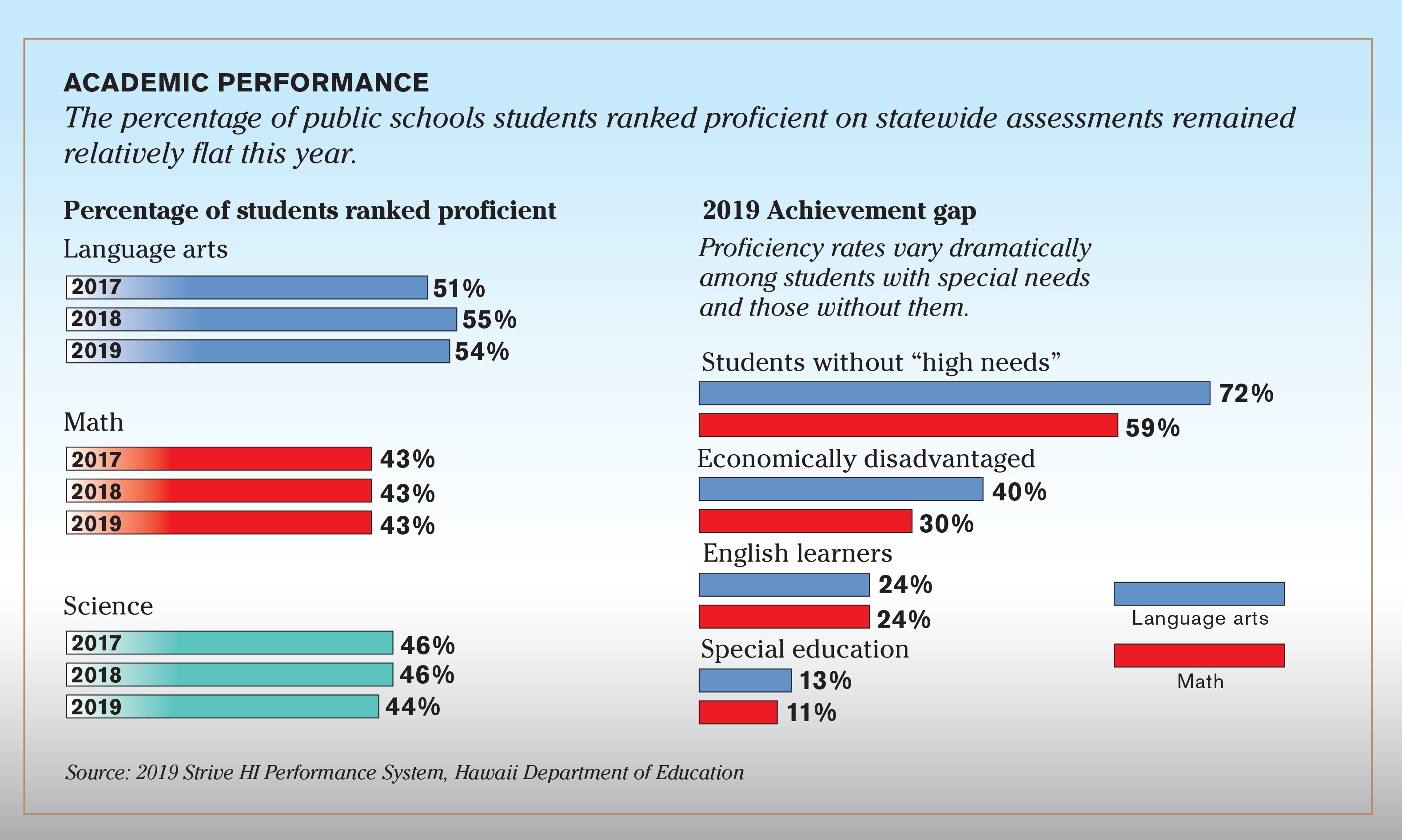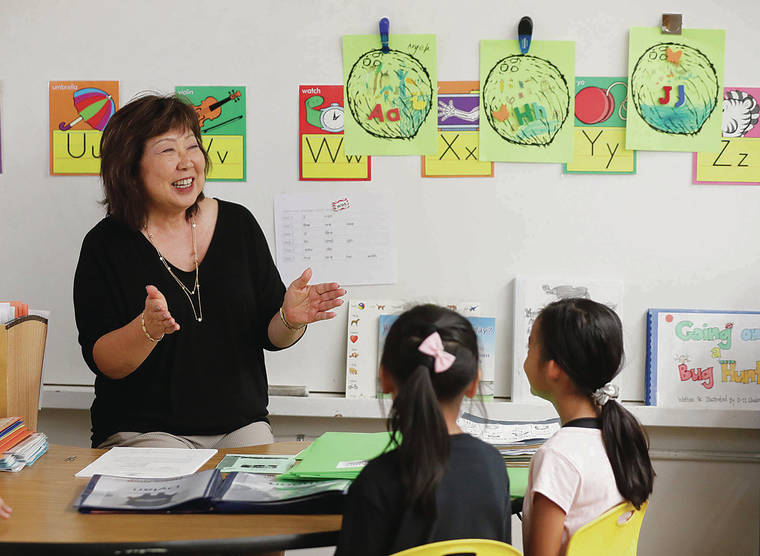The academic performance of Hawaii public school students stagnated this year, with the proficiency rate in math staying flat and slight dips in language arts and science.
But more high school students are taking college-level courses and completing career and technical education programs, according to the 2018-2019 Strive HI report presented to the Board of Education at its meeting Thursday.
“We are not satisfied with the results,” said Donna Lum Kagawa, assistant superintendent for curriculum and instructional design. “Any time there is a lack of a positive trajectory, it means we have to work harder as a system.”
Academic achievement was highest in language arts, with 54% of students proficient this year, 1 percentage point below last year but still an improvement over 2017, when 51% of students reached proficiency. Math proficiency remained stuck at 43% in 2019, the same as the previous two years.

The Smarter Balanced Assessment in math and language arts is aligned with the Common Core curriculum adopted by various states. Many have not yet released their results for this year, so it’s not clear yet how Hawaii will stack up, but so far it appears to be similar to others.
“The Smarter Balanced numbers by themselves are disappointing, but I want to provide some context,” said board member Bruce Voss. “I looked at a couple of states that reported 2019 results — Oregon, Delaware and Connecticut. Their statewide results are strikingly similar to ours: stagnating or even slightly decreasing English scores, little to no improvement in math.”
“I continue to struggle with whether this test is an accurate measure of real-world proficiency,” he added.
Science proficiency slipped slightly to 44% this year from 46% in the previous two years in Hawaii. This year’s test was different, developed as a bridge to the Next Generation Science Standards that will be adopted in full next year.
Big achievement gaps in math and English persist for students with “high needs,” defined as those in special education, low-income households or learning English as a second language.
Overall, 72% of students who don’t have such challenges reached proficiency in language arts, compared with 38% of students with high needs. In math, 59% of students without disadvantages were proficient, compared with 30% for high-need students.
Despite relatively low achievement levels, English learners and students in special education have shown solid progress over the last three years in proficiency rates in math as well as language arts.
Strive HI includes individual reports for each school so educators and families can examine in detail how they are doing, and adjust and learn from each other.
Jarrett Middle School, for example, has made great strides in science, with 61% of students proficient, up from 53% in 2018 and 34% in 2017. Its students also improved their performance in math as well as language arts this year to exceed or meet statewide averages.
The results are remarkable since the school serves far more needy students than public schools as a whole, who tend to start off behind academically. Three out of 4 Jarrett students are in low-income households, compared with 1 out of 2 statewide, and the campus has more students in special education.
“Our biggest push is trying to get the kids to buy into this mindset of being — the word I use is — ‘extraordinary,’” said Principal Reid Kuba. “If we do things like everyone else and we don’t strive for extraordinary, at the end of the year, since they come to us behind, they’ll still be behind. It’s this mindset of, What little extra are you going to do that will push you ahead or at least catch up?”
He credits his teachers for their commitment to the school and for coming up with creative ways to reach their students. Time for professional development in the new, more rigorous science standards seems to have paid off, along with new techniques for math instruction.
“Rather than teaching to the whole class and lecturing, kids are in groups of maybe four or five, solving problems together, so they’re talking about the math, using the vocabulary,” Kuba said. “Each group uses a whiteboard, so everybody can see their work. There’s a lot more engagement.”
More than half of the 274 students at Jarrett stick around after school to do homework, some in organized tutoring programs and others teaming up with friends in “study spaces,” using school computers, with teachers rotating to supervise them.
A bright spot in the statewide Strive HI report came in college and career readiness. The number of high school students taking Advanced Placement and dual-credit college classes has risen substantially. For the class of 2018, 45% of students took such courses, up from 33% for the class of 2014.
More students are also completing career and technical education programs, reaching a high of 58% for the class of 2019, up by 8 percentage points from last year. The statewide graduation rate also trended upward to 84.4% in 2019 from 81.5% in 2015.
“The most critical thing we can do for our students is make sure the learning they experience is rigorous, is real-world and is applied,” said schools Superintendent Christina Kishimoto. “I treat the assessments as one measure of many that we have to look at.”
At Haiku Elementary on Maui, Principal Tami Haili set an ambitious goal of improving proficiency rates by 10 percentage points in her first year at the helm — and her students and faculty rose to the challenge. This year 64% of students were proficient in language arts, up from 50% the previous year, while 46% were proficient in math, up from 36%.
“A lot of it had to do with the way we looked at data,” she said. “We were constantly collecting data, analyzing it and providing targeted instruction for students. … What you saw was schoolwide growth.”
“We have a very committed staff,” Haili said. “They understood that we needed to grow. Not only the teachers — the students were committed, the staff were committed and the parents are super supportive.”
Strive HI State Snapshot by Honolulu Star-Advertiser on Scribd


